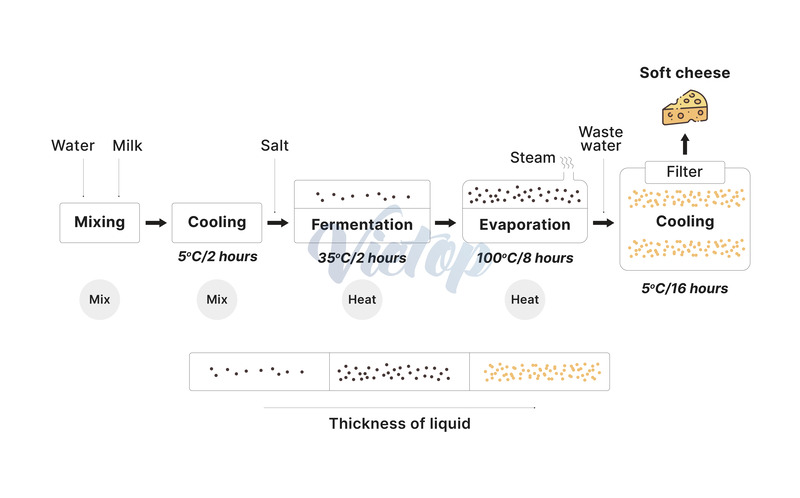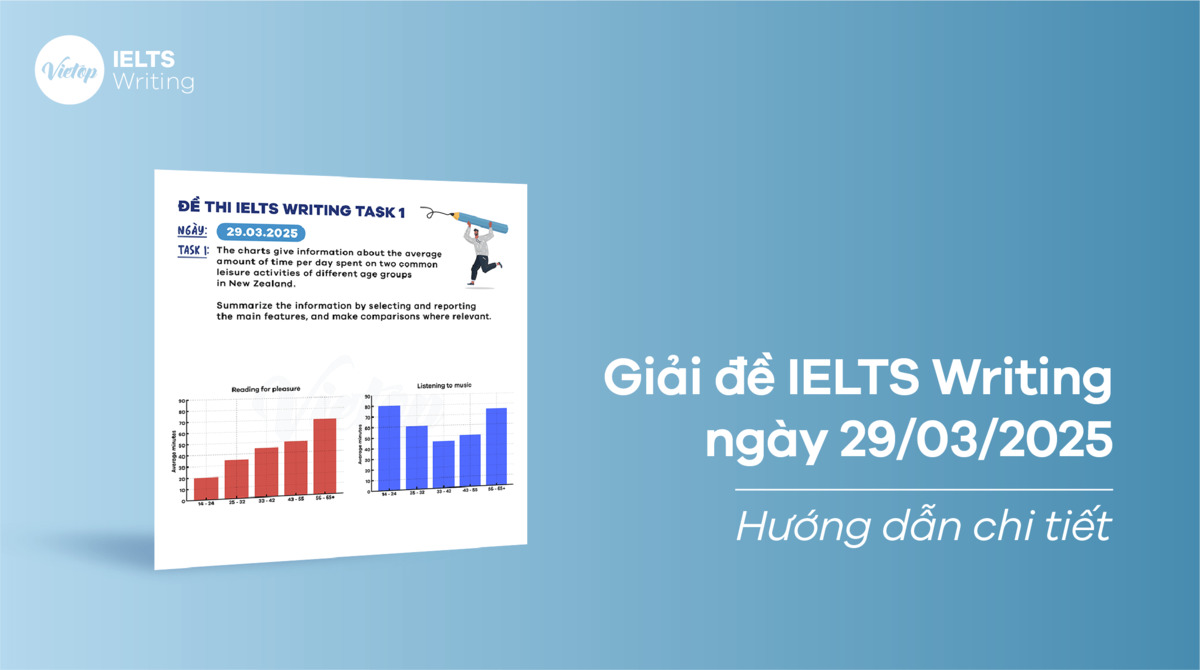Cùng xem chi tiết đề thi IELTS Writing ngày 10/10/2024 với dạng Process ở Task 1 và trong Task 2 yêu cầu thí sinh phân tích hai quan điểm liên quan tới tăng trưởng kinh tế với dạng Discuss both views như sau:
- Đề IELTS Writing Task 1: The diagram below shows the process of making soft cheese. Summarise the information by selecting and reporting the main features and make comparisons where relevant.
- Đề IELTS Writing Task 2: Some say that economic growth is the only way to eliminate world poverty and hunger, while others say that economic growth is destroying the environment and must stop. Discuss these two views and give your own opinion.
Để nắm vững cách viết Task 1 và Task 2 trong phần Writing của IELTS, chúng ta sẽ tiến hành phân tích biểu đồ Process trong Task 1 và đưa ra quan điểm cá nhân trong Task 2 bằng cách tham khảo các bài mẫu theo từng band điểm từ bài giải đề IELTS Writing ngày 10/10/2024.
1. IELTS Writing Task 1
| The diagram below shows the process of making soft cheese. Summarise the information by selecting and reporting the main features and make comparisons where relevant. |
| (Biểu đồ bên dưới cho thấy quá trình làm phô mai mềm. Tóm tắt thông tin bằng cách lựa chọn và báo cáo những đặc điểm chính và so sánh ở những chỗ liên quan) |

1.1. Bước 1: Phân tích đề
- Dạng biểu đồ: Process
- Topic: Making soft cheese
- Place: Không được nhắc tới
- Number of factors: Không được nhắc tới
- Time: Không được nhắc tới
- Tense: Các thì hiện tại, có cấu trúc bị động
1.2. Bước 2: Lập dàn ý
Introduction: Paraphrase đề bài.
Overview:
- Overall, the process of making cheese involves five distinct stages: mixing, cooling, fermentation, evaporation, and final cooling.
| Body paragraph 1 | Body paragraph 2 |
| – Water and milk are combined in a mixer to form the base mixture, then cooled to 5C for 2 hours. – Salt is added to initiate the fermentation process. Fermentation takes place at 35C for 2 hours. | – The mixture is evaporated at 300C for 8 hours, removing excess moisture and thickening the mixture. – Then, the mixture is cooled again at 5C for another 8 hours. – Finally, the cheese is filtered, separating soft cheese and wastewater through an outlet. |
Xem thêm:
- Cách viết IELTS Writing Task 1 từ A – Z cho người mới bắt đầu
- Cách viết overview task 1 – Những yếu tố quan trọng cần nắm vững
- Những cấu trúc ăn điểm trong IELTS Writing Task 1 mà bạn không nên bỏ qua
1.3. Bước 3: Bài mẫu
1.3.1. Bài mẫu band 5.0+
The chart show how soft cheese is make and what ingredients are needed, also how long each stage take.
In total, there is five main steps: Mixing, cooling, fermentation, evaporation, and then cooling again.
At first, water and milk are mix in a mixer. After this, the mixture are cooled for 2 hours at 5 degrees. Then, salt is added to start fermentation. This step takes 2 hours at a temperature of 35 degrees.
Next, the mixture get heated to 300°C for 8 hours in the evaporation process. After that, it’s cooled for 8 hours again at 5°C. In the last step, the cheese is filtered and the water is removed, leaving soft cheese at the end.
1.3.2. Bài mẫu band 7.0+
The diagram illustrates the step-by-step process of making soft cheese, outlining the required ingredients and the time each stage takes.
Overall, the production of soft cheese involves five stages: Mixing, cooling, fermentation, evaporation, and final cooling.
Initially, water and milk are mixed in a mixer. This mixture is then cooled for 2 hours at a temperature of 5°C. Once cooled, salt is added to the mixture to begin the fermentation process, which takes place over 2 hours at 35°C.
After fermentation, the mixture enters the evaporation stage, where it is heated to 300°C for 8 hours. This causes the mixture to thicken. Finally, the mixture undergoes another cooling stage for 8 hours at 5°C, after which the cheese is filtered, and the wastewater is removed through a separate outlet, leaving the soft cheese ready for use.
1.4. Từ vựng
| Từ vựng | Nghĩa |
| Step-by-step process /stɛp-baɪ-stɛp ˈprəʊsɛs/ | (noun phrase) quy trình từng bước E.g. He explained the step-by-step process for building a computer. (Anh ấy đã giải thích quy trình từng bước để lắp ráp máy tính.) |
| Fermentation /ˌfɜːmɛnˈteɪʃᵊn/ | (noun) quá trình lên men E.g. Fermentation is an essential step in making yogurt. (Quá trình lên men là một bước quan trọng trong việc làm sữa chua.) |
| Evaporation /ɪˌvæpəˈreɪʃᵊn/ | (noun) sự bay hơi E.g. Evaporation causes water to disappear from the surface on a hot day. (Sự bay hơi khiến nước biến mất khỏi mặt đất trong một ngày nóng.) |
| Undergo /ˌʌndəˈɡəʊ/ | (verb) trải qua E.g. The patient will undergo surgery tomorrow. (Bệnh nhân sẽ bị phẫu thuật trong ngày mai.) |
| Outline /ˈaʊtlaɪn/ | (verb) phác thảo, minh họa, liệt kê E.g. The teacher asked the students to outline the main points of the chapter. (Giáo viên yêu cầu các sinh viên liệt kê ra các ý chính của chương.) |
| Filter /ˈfɪltə/ | (verb) lọc E.g. Water is filtered before it reaches the tap. (Nước được lọc trước khi tới vòi.) |
| Outlet /ˈaʊtlɛt/ | (noun) đầu ra, đường ra, lỗ thoát E.g. The outlet at the bottom of the tank allows water to drain out. (Lỗ thoát dưới đáy bồn nước cho nước thoát ra ngoài.) |
1.5. Cấu trúc
1.5.1. Câu phức với mệnh đề quan hệ với which
| S + V, which + V |
E.g. Once cooled, salt is added to the mixture to begin the fermentation process, which takes place over 2 hours at 35°C.
(Khi đã nguội, muối được thêm vào hỗn hợp để bắt đầu quá trình lên men, kéo dài trong vòng 2 tiếng ở 35C.)
1.5.2. Câu sử dụng cụm phân từ với hiện tại phân từ
| S + V, V-ing + O |
E.g. The diagram illustrates the step-by-step process of making soft cheese, outlining the required ingredients and the time each stage takes.
(Sơ đồ biểu diễn quá trình làm phô mai mềm theo từng bước, có liệt kê các thành phần cần thiết và thời gian của mỗi bước.)
Xem thêm:
- Cách viết Writing Task 1 dạng Table
- Cách viết Writing Task 1 Line Graph
- Cách viết Pie Chart IELTS Writing Task 1
2. IELTS Writing Task 2
| Some say that economic growth is the only way to eliminate world poverty and hunger, while others say that economic growth is destroying the environment and must stop. Discuss these two views and give your own opinion. |
| (Một số người cho rằng tăng trưởng kinh tế là cách duy nhất để xóa nạn đói nghèo trên toàn thế giới, trong khi những người khác cho rằng tăng trưởng kinh tế đang phá hủy môi trường và cần phải bị dừng lại. Phân tích hai quan điểm trên rồi cho ý kiến cá nhân của bạn.) |
2.1. Bước 1: Phân tích đề
- Dạng bài: Discuss both views
- Từ khóa: Economic growth, eliminate, world poverty, hunger, destroying, environment.
- Phân tích yêu cầu: Đề bài yêu cầu bạn phân tích quan điểm tăng trưởng kinh tế là cách duy nhất để xóa đói giảm nghèo, và quan điểm tăng trưởng kinh tế làm hư môi trường, rồi sau đó đưa ra quan điểm của riêng bạn.
2.2. Bước 2: Lập dàn ý
| Introduction: Viết lại đề bài theo cách khác, sau đó đưa ra quan điểm cá nhân. | |
| Body paragraph 1: – Point: Economic growth is seen as an effective way to reduce poverty and hunger globally. + Explanation 1: Economic growth generates employment, boosts income levels, and improves access to essential services like healthcare, education, and social welfare. + Example 1: In countries like China and India, rapid economic development has lifted millions out of poverty over the past few decades. + Explanation 2: Economic growth increases government revenues, allowing more investment in public services and infrastructure that directly aid poor communities. + Example 2: Improved agricultural practices due to economic growth result in higher crop yields, which help address hunger issues in developing countries. | Body paragraph 2: – Point: Economic growth harms the environment, leading to long-term consequences. + Explanation 1: Industrial expansion and the demand for resources cause deforestation, depletion of natural resources, and pollution. + Example 1: The Amazon rainforest is being destroyed for industrial purposes, threatening biodiversity and increasing carbon emissions. + Explanation 2: Economic growth often leads to higher carbon footprints, contributing to climate change + Example 2: Rising sea levels and droughts in vulnerable regions like Africa and Southeast Asia exacerbate poverty and hunger. |
| Body paragraph 3: Personal opinion – Point: While economic growth is vital for addressing poverty and hunger, it must be pursued in an environmentally responsible way. + Explanation 1: Sustainable development seeks to balance economic progress with environmental conservation. + Link: Sustainable development offers a compromise between eliminating poverty and protecting the environment. | |
| Conclusion: Viết lại mở bài theo cách khác, nhắc lại quan điểm cá nhân. Tóm tắt các main idea đã viết trong các đoạn thân bài. | |
2.3. Bước 3: Bài mẫu
2.3.1. Bài mẫu band 5.0+
Some people believe that economic growth is the best way to solve poverty and hunger in the world. But others think that this growth is damaging the environment and should be stop. In this essay, I will discuss both of these views and give my opinion.
On one hand, economic growth can reduce poverty because it makes more jobs and improves living conditions. For example, in China and India, many people has been lifted out of poverty due to economic growth. Also, economic growth help to increase food production because it supports new technologies in agriculture. So, more food can be produce to feed poor people.
On the other hand, many believe that economic growth is causing big problems for the environment. For example, the Amazon rainforest is being cut down so that companies can use the land for farming and industry. This not only destroys nature but also increase pollution and climate change. Climate change is making life harder for poor people because they suffer from things like floods and droughts.
In my opinion, we should not stop economic growth because it is important to fight poverty and hunger. However, I think that governments should focus more on protecting the environment while allowing some growth. We can use green energy and better technologies that do not damage the nature so much.
In conclusion, economic growth is important for reducing poverty and hunger, but we need to make sure it does not destroy the environment. Finding a balance between growth and protection is the best solution.
2.3.2. Bài mẫu band 7.0+
Economic growth is often viewed as the most effective solution for reducing poverty and hunger. However, many argue that it harms the environment, causing irreparable damage. This essay will discuss both views and provide my personal opinion.
On one hand, economic growth can significantly reduce poverty and hunger. It creates jobs, improves infrastructure, and enhances access to essential services such as healthcare and education. For example, countries like China and India have lifted millions of people out of poverty through rapid economic development. Furthermore, technological advancements driven by economic growth improve agricultural productivity, resulting in higher food production, which helps combat hunger in underdeveloped regions.
On the other hand, unchecked economic growth can have devastating effects on the environment. Industrial expansion leads to deforestation, pollution, and the depletion of natural resources. For instance, the Amazon rainforest is being destroyed at an alarming rate to make way for agriculture, contributing to climate change. This environmental degradation disproportionately affects impoverished communities, making them more vulnerable to extreme weather events and food insecurity.
In my opinion, while economic growth is essential for reducing poverty, it should not come at the cost of environmental sustainability. Governments and businesses must adopt sustainable development strategies that balance economic progress with environmental protection. For instance, investment in renewable energy and green technologies can help achieve economic growth without further harming the planet.
In conclusion, while economic growth is necessary for tackling poverty and hunger, it must be pursued responsibly. A focus on sustainable development can provide a solution that benefits both the economy and the environment.
Xem thêm:
- Cách viết dạng Positive & Negative – IELTS Writing Task 2
- Cách viết Cause and Effect Essay – IELTS Writing Task 2
- Cách làm dạng bài IELTS Writing Task 2 – Agree or Disagree chi tiết
2.4. Từ vựng
| Từ vựng | Nghĩa |
| Irreparable damage /ɪˈrɛpərəbᵊl ˈdæmɪʤ/ | (noun phrase) Thiệt hại không thể khắc phục E.g. The fire caused irreparable damage to the old library. (Đám cháy đã gây ra thiệt hại không thể khắc phục cho thư viện cũ.) |
| Significantly /sɪɡˈnɪfɪkᵊntli/ | (adverb) một cách đáng kể E.g. The new policy has significantly improved the company’s productivity. (Chính sách mới đã cải thiện đáng kể năng suất của công ty.) |
| Essential services /ɪˈsɛnʃᵊl ˈsɜːvɪsɪz/ | (noun phrase) dịch vụ thiết yếu E.g. During the lockdown, only essential services were allowed to operate. (Trong thời gian phong tỏa, chỉ có các dịch vụ thiết yếu được phép hoạt động.) |
| Technological advancements /ˌtɛknəˈlɒʤɪkᵊl ədˈvɑːnsmənts/ | (noun phrase) những tiến bộ công nghệ E.g. Technological advancements have transformed the way we communicate. (Những tiến bộ công nghệ đã thay đổi cách chúng ta giao tiếp.) |
| Agricultural productivity /ˌæɡrɪˈkʌlʧᵊrᵊl ˌprɒdʌkˈtɪvəti/ | (noun phrase) năng suất nông nghiệp E.g. Improving agricultural productivity is crucial for ensuring food security. (Nâng cao năng suất nông nghiệp rất quan trọng để đảm bảo an ninh lương thực.) |
| Underdeveloped regions /ˌʌndədɪˈvɛləpt ˈriːʤᵊnz/ | (noun phrase) những khu vực kém phát triển E.g. Governments are focusing on improving infrastructure in underdeveloped regions. (Các chính phủ đang tập trung cải thiện cơ sở hạ tầng tại các khu vực kém phát triển.) |
| Unchecked economic growth /ʌnˈʧɛkt ˌiːkəˈnɒmɪk ɡrəʊθ/ | (noun phrase) tăng trưởng kinh tế không kiểm soát E.g. Unchecked economic growth can lead to environmental degradation. (Tăng trưởng kinh tế không kiểm soát có thể dẫn đến suy thoái môi trường.) |
| Devastating /ˈdɛvəsteɪtɪŋ/ | (adjective) tàn khốc, gây hại nghiêm trọng E.g. The earthquake had a devastating impact on the city. (Trận động đất đã gây ra tác động tàn khốc cho thành phố.) |
| Deforestation /dɪˌfɒrɪˈsteɪʃᵊn/ | (noun) nạn phá rừng E.g. Deforestation is a major cause of climate change and biodiversity loss. (Nạn phá rừng là nguyên nhân chính gây biến đổi khí hậu và mất đa dạng sinh học.) |
| Climate change /ˈklaɪmət ʧeɪnʤ/ | (noun phrase) biến đổi khí hậu E.g. Climate change is a global challenge that requires urgent action. (Biến đổi khí hậu là một thách thức toàn cầu cần có hành động khẩn cấp.) |
| Degradation /ˌdɛɡrəˈdeɪʃᵊn/ | (noun) sự suy thoái E.g. Soil degradation has reduced the land’s ability to support crops. (Sự suy thoái đất đã làm giảm khả năng của đất trong việc hỗ trợ trồng trọt.) |
| Disproportionately /ˌdɪsprəˈpɔːʃᵊnətli/ | (adverb) một cách không cân xứng, không cân bằng E.g. The economic crisis disproportionately affected low-income families. (Cuộc khủng hoảng kinh tế đã ảnh hưởng không cân xứng đến các gia đình thu nhập thấp.) |
| Impoverished communities /ɪmˈpɒvərɪʃt kəˈmjuːnətiz/ | (noun phrase) các cộng đồng nghèo khó E.g. Many impoverished communities struggle to access basic healthcare services. (Nhiều cộng đồng nghèo khó gặp khó khăn trong việc tiếp cận các dịch vụ chăm sóc sức khỏe cơ bản.) |
| Vulnerable /ˈvʌlnᵊrəbᵊl/ | (adjective) dễ bị tổn thương E.g. Children and the elderly are often the most vulnerable during natural disasters. (Trẻ em và người già thường là những người dễ bị tổn thương nhất trong các thảm họa thiên nhiên.) |
| Sustainability /səˌsteɪnəˈbɪləti/ | (noun) sự bền vững E.g. Sustainability is key to ensuring that future generations can meet their needs. (Sự bền vững là yếu tố then chốt để đảm bảo các thế hệ tương lai có thể đáp ứng nhu cầu của họ.) |
| Sustainable development strategies /səˈsteɪnəbᵊl dɪˈvɛləpmənt ˈstrætəʤiz/ | (noun phrase) chiến lược phát triển bền vững E.g. Governments around the world are adopting sustainable development strategies to balance economic growth and environmental protection. (Các chính phủ trên toàn thế giới đang áp dụng các chiến lược phát triển bền vững để cân bằng giữa tăng trưởng kinh tế và bảo vệ môi trường.) |
| Renewable energy /rɪˈnjuːəbᵊl ˈɛnəʤi/ | (noun phrase) năng lượng tái tạo E.g. Investing in renewable energy is crucial for reducing our dependence on fossil fuels. (Đầu tư vào năng lượng tái tạo là rất quan trọng để giảm sự phụ thuộc vào nhiên liệu hóa thạch.) |
| Green technologies /ɡriːn tɛkˈnɒləʤiz/ | (noun phrase) công nghệ xanh E.g. Green technologies play a vital role in combating climate change and reducing environmental impact. (Công nghệ xanh đóng vai trò quan trọng trong việc chống lại biến đổi khí hậu và giảm tác động đến môi trường.) |
2.5. Cấu trúc
2.5.1. Câu bị động thì hiện tại tiếp diễn
| S + being + V3/ed + O |
E.g. The Amazon rainforest is being destroyed at an alarming rate to make way for agriculture.
(Rừng nhiệt đới Amazon đang bị phá hủy một cách báo động để tạo đất nông nghiệp.)
2.5.2. Câu phức với while
| While + S + V1, S + V2 |
E.g. While economic growth is essential for reducing poverty, it should not come at the cost of environmental sustainability
(Công cuộc tăng trưởng kinh tế rất quan trọng để giảm nghèo, nhưng không nên đánh đổi bằng sự bền vững của môi trường.)
2.5.3. Câu phức với that và cụm phân từ
| S1 + V1 + that + S2 + V2, V-ing + O |
E.g. Many argue that it harms the environment, causing irreparable damage.
(Nhiều người cho rằng điều này gây hại cho môi trường, dẫn đến những tổn thất không thể khắc phục được.)
Xem thêm các bài giải mẫu khác:
- [ACE THE TEST] Giải đề IELTS Writing ngày 05/10/2024
- [ACE THE TEST] Giải đề IELTS Writing ngày 28/09/2024
- [ACE THE TEST] Giải đề IELTS Writing ngày 19/09/2024
- Tổng hợp đề thi IELTS Writing 2024 kèm bài mẫu chi tiết
3. Kết bài
Như vậy, chúng ta vừa hoàn thành việc phân tích, xây dựng dàn ý và cách viết bài mẫu theo từng band điểm trong bài giải đề IELTS Writing ngày 10/10/2024 phía trên.
Hy vọng với những thông tin chia sẻ trong bài viết sẽ giúp bạn nắm được cách phân tích trước khi triển khai viết bài luận. Đừng ngần ngại để lại câu hỏi trong phần bình luận nếu cần sự hỗ trợ kịp thời từ thầy.
Chúc các bạn ôn tập tốt và đạt được kết quả cao trong kỳ thi IELTS sắp tới!


![[ACE THE TEST] Giải đề IELTS Writing ngày 07/04/2025](https://vietop.edu.vn/wp-content/uploads/2025/04/giai-de-ielts-writing-ngay-07-04-2025.png)

![[ACE THE TEST] Giải đề IELTS Writing ngày 15/03/2025](https://vietop.edu.vn/wp-content/uploads/2025/03/giai-de-ielts-writing-ngay-15-03-2025.jpg)
![[ACE THE TEST] Giải đề IELTS Writing ngày 22/03/2025](https://vietop.edu.vn/wp-content/uploads/2025/03/giai-de-ielts-writing-ngay-22-03-2025.jpg)
![[ACE THE TEST] Giải đề IELTS Writing ngày 08/03/2025](https://vietop.edu.vn/wp-content/uploads/2025/03/giai-de-ielts-writing-ngay-08-03-2025.jpg)
![[ACE THE TEST] Giải đề IELTS Writing ngày 06/03/2025](https://vietop.edu.vn/wp-content/uploads/2025/03/giai-de-ielts-writing-ngay-06-03-2025.jpg)
![[ACE THE TEST] Giải đề IELTS Writing ngày 22/02/2025](https://vietop.edu.vn/wp-content/uploads/2025/02/giai-de-ielts-writing-ngay-22-02-2025.jpg)
